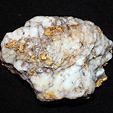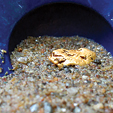All Articles
Legislative and Regulatory Update
December 2001 by Staff
• State officials rip EPA plan for Coeur d’Alene BasinWallace, Idaho (AP)—State and local leaders lined up to take potshots at the U.S. Environmental Protection Agency’s plan to clean up toxic mining wastes in the Silver Valley and advance a state-run program.
“I am so frustrated with the EPA that I am on the verge of inviting the EPA to leave the the state of Idaho,” Governor Dirk Kempthorne said at the first in a series of public hearings. “We have just about exhausted our patience with the EPA.”
Kempthorne said the state has the ability and resources to accomplish the task.
The federal agency last month proposed a $359 million cleanup that could take up to 30 years to accomplish and create one of the nation’s largest Superfund sites.
The cleanup would run from Mullan near the Montana state line, to Upriver Dam near the city of Spokane, Washington, a distance of about 100 miles.
US Senator Michael Crapo, R-Idaho, has introduced a bill to spend $250 million in non-Superfund money for a state-run cleanup. In testimony for the hearing, Crapo criticized the agency’s intent to expand the Superfund site out of the Kellogg-area “box.”
“No one was given notice and the opportunity to comment that the Superfund designation for the Bunker Hill Box would be applied to the entire basin,” he said. “Local communities have objected to this idea and the Idaho congressional delegation has requested the EPA’s national ombudsman to investigate whether or not this expansion is warranted.”
Lt. Gov. Jack Riggs said that from a physician’s standpoint, he believes the health risk is over, based on the most recent information about blood-lead levels in local children.
“Poverty is just as damaging to our children as exposure to lead,” Kempthorne said. “We must focus on economic development.”
• Judge keeps parts of suit over cyanide ban alive
A US District Court rejected the State of Montana’s motion to dismiss a federal lawsuit by Canyon Resources. Canyon filed suit to either overturn Montana’s initiative I-137, which banned the use of cyanide, or obtain a “takings” damage award.
A second lawsuit, filed in state court, was reviewed by Judge Jeffrey Sherlock of Helena. He tossed out much of the case, but reserved judgement on whether the cyanide ban illegally took away the ability of Canyon Resources to make money from the proposed mine.
Sherlock said it is unlikely the company will be able to prove the claim. The leases obtained by Canyon Resources to use state land at the mine site included an agreement to abide by any mining or environmental regulations, the judge noted.
Sherlock dismissed company claims that the cyanide ban violated rights of due process and equal protection of the laws. In order to survive those constitutional challenges, the state needed only a reasonable purpose for enacting the law, and protecting the environment from possible cyanide spills is sufficient reason, he said.
The ruling leaves the crucial question of whether the leases gave Canyon Resources a property right to mine.
• Change in arsenic standard will be felt in rural areas
Washington, (AP)—Within five years, drinking water in the United States will have to meet a new and tougher arsenic standard now being adopted by the Bush administration.
The administration’s about-face on a standard issued in the last days of the Clinton presidency will be felt particularly in rural towns among Western mining states where arsenic, both a naturally occurring substance and industrial byproduct, is found in high concentrations.
Environmental Protection Agency Administrator Christie Whitman said the decision to adopt the new standard will reduce the maximum amount of arsenic allowed in drinking water from 50 parts per billion—a level first set in 1942—to 10 ppb by 2006.
“A standard of 10 ppb protects public health based on the best available science and ensures that the cost of the standard is achievable,” Whitman said in a letter to House Appropriations Chairman Rep. Bill Young, R-Florida.
One part per billion is the equivalent of one drop of water in a 10,000 gallon swimming pool.
Last month, the National Academy of Sciences issued a report to Whitman saying the agency had greatly underestimated the cancer risks of arsenic in drinking water.
The risks are much higher than the agency had acknowledged even for low levels of arsenic in tap water, the report said. Even at 3 ppb, it said, the risk of bladder and lung cancer from arsenic exposure is between four and 10 deaths per 10,000 people. The EPA’s maximum acceptable level of risk for the past two decades for all drinking water contaminants has been one death in 10,000.
Whitman had asked the academy to study the health effects of establishing a standard of 3, 5, 10 or 20 parts per billion. At each level, the study found, the cancer risks were much higher than the EPA had estimated.
The EPA estimates that one in 20 water systems, or about 4,100 nationwide, will have to treat their water to meet the new standard. Some 97 percent of those are small systems serving communities of fewer than 10,000 people.
To help ease the financial burden, the EPA plans to provide $20 million for researching the most cost-effective technologies to meet the new standard, Whitman said.
“These communities will need help if they are to comply with the standard,” said Sen. Harry Reid, D-Nev., who supports the 10 ppb standard but hopes Congress will provide $750 million annually so many of the towns and native tribes like those in his mining state can upgrade their water systems.

© ICMJ's Prospecting and Mining Journal, CMJ Inc.
Next Article »« Previous Article
Additional articles that might interest you...
Determining the Amount of Gold in Rich Ores
February 2016
 This is just the type of specimen that could have been easily ignored by the old-time miners. It felt a little heavier in my hand than a chunk of quartz of that size ought to have been.
This is just the type of specimen that could have been easily ignored by the old-time miners. It felt a little heavier in my hand than a chunk of quartz of that size ought to have been.
 This is just the type of specimen that could have been easily ignored by the old-time miners. It felt a little heavier in my hand than a chunk of quartz of that size ought to have been.
This is just the type of specimen that could have been easily ignored by the old-time miners. It felt a little heavier in my hand than a chunk of quartz of that size ought to have been.
Picks & Pans: All That Glitters Pans Out Well!
August 2001
Armed with my heavy bucket of gravel and, most importantly, my gold pan, I anxiously waded knee-deep into the mucky water. At the ready, the swish-swash splish-splash was all I heard as I hurriedly shook my gold pan, turfing out all the bigger bits of rock and clumps of mud. My clean clothes and even my face were soon splattered with mud in my race to pan as much gold in 20 minutes as my spindly arms would allow!
Armed with my heavy bucket of gravel and, most importantly, my gold pan, I anxiously waded knee-deep into the mucky water. At the ready, the swish-swash splish-splash was all I heard as I hurriedly shook my gold pan, turfing out all the bigger bits of rock and clumps of mud. My clean clothes and even my face were soon splattered with mud in my race to pan as much gold in 20 minutes as my spindly arms would allow!
Mining Stock Quotes and Mineral & Metal Prices
December 2007
Prospecting Hard Rock
March 2014
 We panned out maybe three gold pans of the material and we were shocked at the gold that was there. This rock appeared to be rich.
We panned out maybe three gold pans of the material and we were shocked at the gold that was there. This rock appeared to be rich.
 We panned out maybe three gold pans of the material and we were shocked at the gold that was there. This rock appeared to be rich.
We panned out maybe three gold pans of the material and we were shocked at the gold that was there. This rock appeared to be rich.
Prospecting Old Mine Dumps With A Drone
November 2020
 Due to the lockdown, I spent lots of time indoors this spring and I decided to add a drone as a faithful mate in my research.
Due to the lockdown, I spent lots of time indoors this spring and I decided to add a drone as a faithful mate in my research.
Collecting Garnets in Wyoming
April 2000
In Wyoming, garnets are often common where aluminum-rich (micaceous) rocks have been highly metamorphosed. Such rocks are recognized by abundant black (biotite), silver (muscovite), or green (chlorite) mica with periodic grains of red garnet.
In Wyoming, garnets are often common where aluminum-rich (micaceous) rocks have been highly metamorphosed. Such rocks are recognized by abundant black (biotite), silver (muscovite), or green (chlorite) mica with periodic grains of red garnet.
Subscription Required:
The Bawl Mill
• Our Readers Say
• 43 CFR 3809 Update
• Breccia Pipes
• Newmont Tries to Become World's Largest
• The Final Gold Strike of the Alaska Gold Rush—Livengood Stampede, 1914
• GATA Update
• Aussie Gold—A Look at Queensland
• Montana's Virginia City Has Golden Legacy
• Picks & Pans: Lost Below
• Placer Gemstones
• Gold in Iceland?
• Mining Stock Quotes and Mineral & Metal Prices
• Melman on Gold & Silver
Free:









